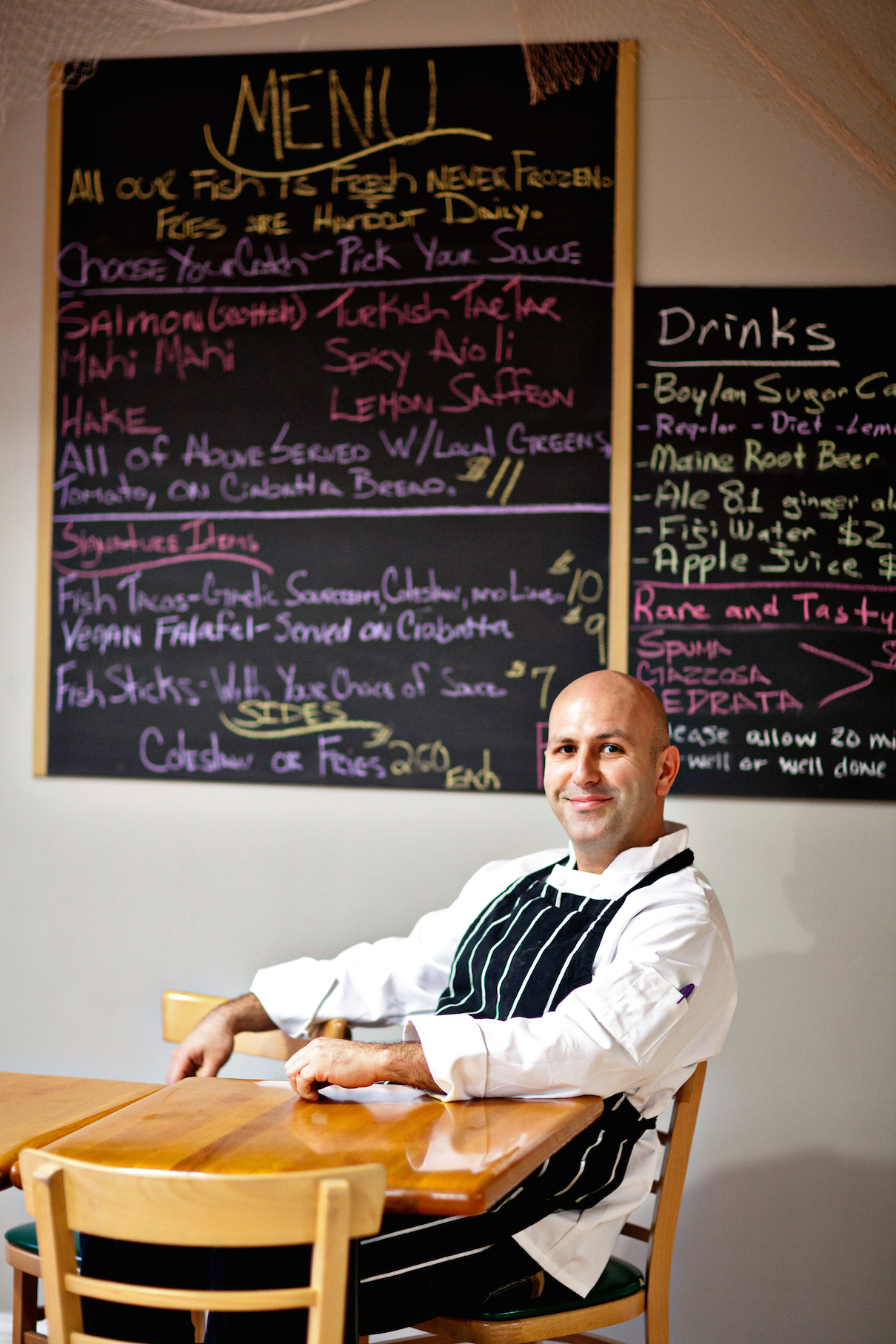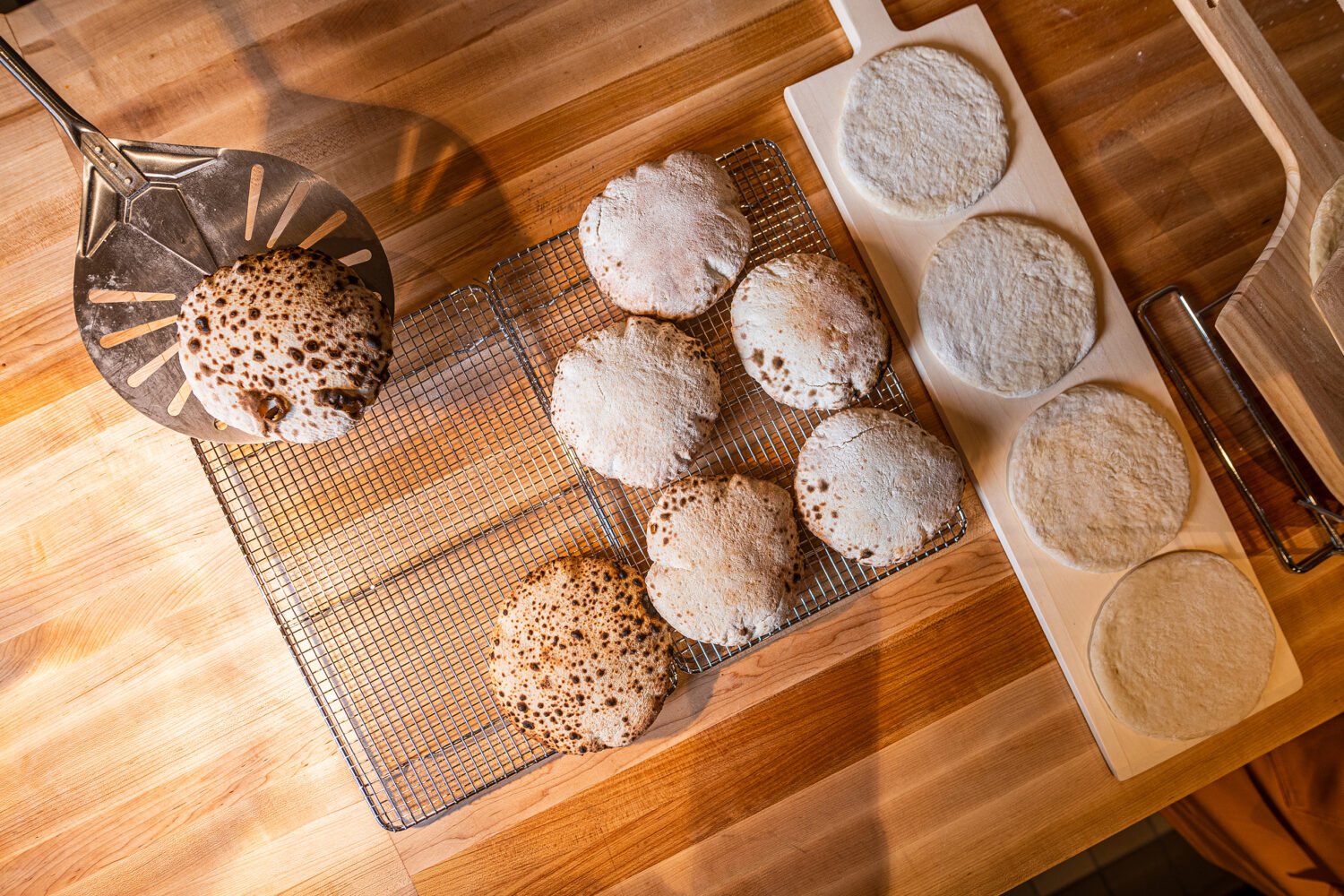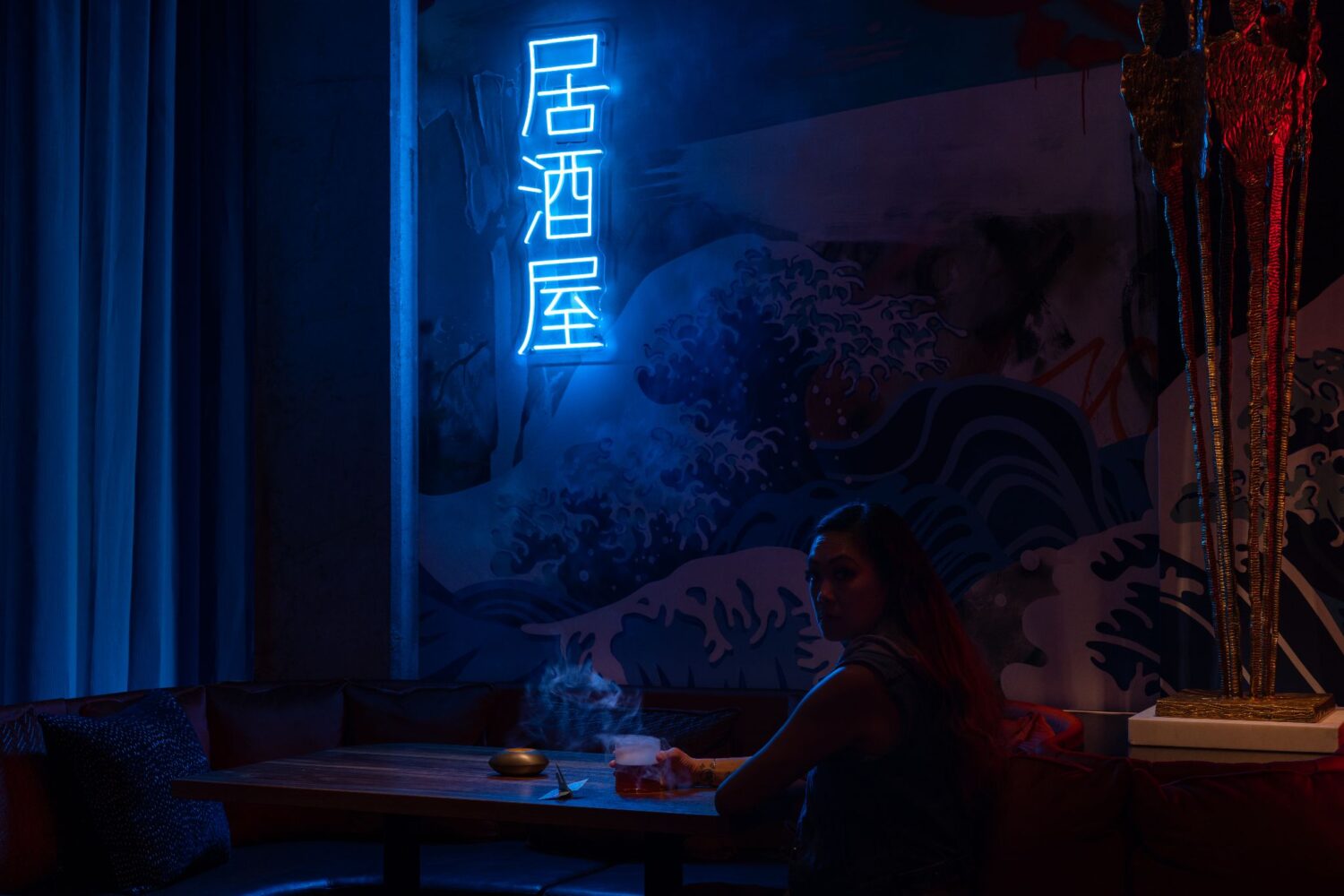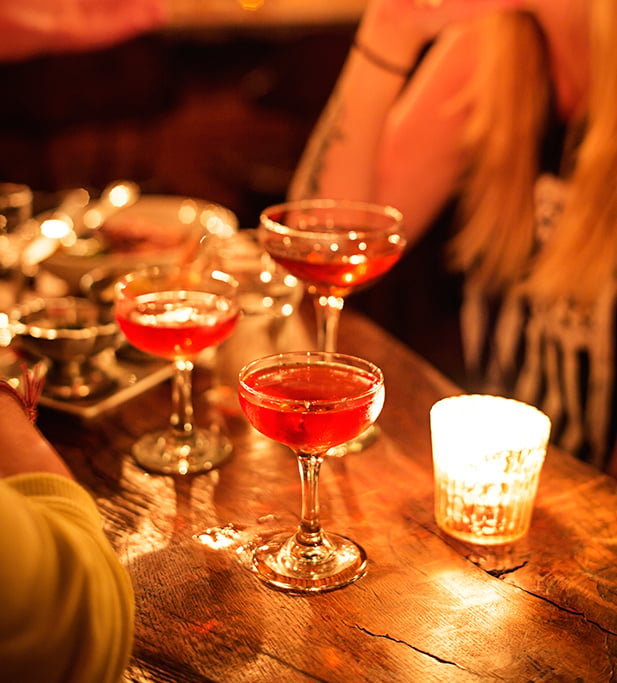
This is the story of a sandwich.
It is also a business story.
And a culture story.
And a class story.
And a story of the gentrification wars in a city that is lurching, painfully at times, from one identity to another.
All of which is to say: it is not a story of bread, filling and condiment.
When Ferhat Yalcin opened Fishnet in College Park, in the fall of 2011, his self-imposed mandate was to bring the fish sandwich he’d been weaned on in his native Istanbul to the foodie masses. Balik ekmek, the sandwich is called–“fish bread,” in Turkish–and it consists, generally, of a couple grilled fresh mackerels slipped inside a half loaf of crusty bread and dressed up with a Turkish tartar sauce made from ground walnuts and olive oil, along with a scoop of what the Turks call salata (lettuce, tomato and onions)
Everyone in Istanbul eats balik ekmek: businessmen, laborers, tourists. To Yalcin, it is more quintessentially Turkish than empires, or ottomans, or Orhan Pamuk. When he came to the US 15 years ago to attend Virginia Tech, it was balik ekmekthat he missed most, the humble sandwich summoning memories of walking along the river, catching sun, enjoying the simple pleasures of the city.
By the time he started Fishnet, Yalcin was a restaurant vet. He had risen from “breakfast server” at Tom Power’s original Corduroy to become general manager, entrusted with making dinner go smoothly for VIPs. He knew balik ekmekmight be an acquired taste, and so he resolved to introduce the mackerel slowly, after he had won his new customers over with his rockfish and hake sandwiches. For a safety net, he rounded out his menu with fish ’n’ chips, fish chowder, and even a grass-fed beef burger. His approach, he believed, was true to the spirit of the fish stalls along the Bosphorus, in emphasizing freshness (he only used line caught or wild fish) and quality (sourcing only from the first-rate suppliers Power had cultivated in more than two decades in the industry). Even his fish sticks, a bid to make the place kid-friendly, were made with fresh fish and rolled in panko.
It took a while for Yalcin to find an audience, and not just because most Americans don’t know what balik ekmekis. Hidden away on a quiet residential street north of the University of Maryland, far from the heavily trafficked commercial thoroughfare of Rte. 1, the location was not exactly prime real estate, and the prices were in excess of most fast food and “fast casual” options. The cost of a sandwich was around $12–not exorbitant, but if you didn’t know what you were getting, as many customers in the beginning didn’t (Yalcin did not trumpet the words local, seasonal, sustainable on his walls), it felt like a lot of money for a 5-ounce filet on a too-big bun.
The mackerel sandwich, it turned out, was only a sometime special; in trying to cultivate an audience, Yalcin realized that it made sense to stick with what he already was doing, and his most loyal supporters loved his fried hake with turkish tartar sauce and local grilled rockfish with cucumber sauce.
Fishnet survived its first year. Business was not strong, but there was critical support (I wrote an early positive review) and a growing base in College Park.
Year 2 was not significantly better financially than year 1, but when an opportunity came along early last year, Yalcin decided to open a second Fishnet in Shaw.
It was at this point that his sandwich ceased to be just a sandwich and became a signifier.
Yalcin said that he was drawn to open in Shaw because of the swelling population of young urbanites, many in their mid- to late-20s. Here, he thought, was exactly the sort of educated, sophisticated, well-traveled constituency that his fish sandwiches were meant to satisfy.
It was the first, and biggest, of his mistakes as a businessman, and it nearly doomed his operation.
Along with the 14th St. NW corridor, the Southwest waterfront, and Mt. Vernon Square, Shaw has become an immensely attractive parcel of real estate, a neighborhood swelling with action — restaurants, boutiques, galleries — as development in the city has moved east. For all its perceived allure among tastemakers and business titans, however, it remains a “transitional neighborhood”–a neighborhood in the process of throwing off its old self and becoming someone new.
The population of Old Shaw is not a cultivated demographic. It is heavily African-American and aging, and, as in other neighborhoods across the city that have seen an influx of young trendies, there are whispers (often, more than whispers) that older and blacker is being phased out to make way for younger and whiter. In many precincts of black Washingtonian, there has been talk for four decades, now, of The Takeover. The phrase had long been derided by whites in the city and close-in suburbs as parochial and paranoid, but it now has the tang of truth to it. Whites have returned to the city in numbers unimaginable just a generation ago, when, in the aftermath of the ’68 riots, spiraling crime, the crack epidemic, and the lingering taint of Marion Barry, DC was a kind of ghost town at night, pocked with blight and lacking vitality. In 2011, the city’s black population dipped below 50 percent for the first time in 50 years, and some demographers have said that they expect the very slight white majority to continue to increase.
Some of the older blacks of old Shaw tried Yalcin’s version of balik ekmek and were put out, the restaurateur tells me. They saw a fish sandwich that was small and expensive ($12), with strange sauces. They saw pretension. Uppityness.
Above and beyond that, they saw a signifier.
They did not hold back, Yalcin says, in voicing their objections to the stoutly built man with the shaved head behind the counter.
You need to try Horace and Dickey’s.
Your prices are too expensive.
This isn’t a fish sandwich.
Properly speaking, the fish sandwich of Horace and Dickey’s, and of innumerable street corner joints through the city, is not a sandwich at all — it’s a pile-up of three filets of fried whiting or croaker with a couple of slices of Wonder Bread on the side, in case you want to assemble the thing yourself. But that hardly mattered. For many black Washingtonians, this is what is meant by the words “fish sandwich.” The model had been in their families since their grandmothers and grandfathers had migrated north from North Carolina.
Food, beyond the elite kitchens, is largely a cultural matter, which is to say it is largely a tribal matter: people have fierce attachments to the flavors and traditions they grew up on. You see this with gumbo, with New York pizza, with any of the regional variations of barbecue. F with what people know, and they will turn on you with the speed and ferocity of a mother lion defending her cub.

Alex Padro, the Executive Director of Shaw Main Streets (a nonprofit organization that has helped bring more than 170 businesses to the neighborhood since 2003) and a self-described foodie who knows Yalcin from his managerial days at Corduroy, has been following the “dichotomy” since the restaurant opened.
“There are plenty of folks in the neighborhood who have been here for decades and in some cases their entire lives,” Padro says, “and when they heard that there was going to be a fish sandwich place it was like: What does this guy know about fish sandwiches? I know fish sandwiches, I’ve been eating them and making them longer than he has.”
The prices, he says, were “disconcerting,” and led to suspicions that Yalcin was charging more because his rent is higher. Many did not realize “that this product is orders of magnitude fresher than what you’re getting everywhere else.”
One day in the midst of the crisis last summer, Yalcin called me asking for insight, and maybe for help, too. He said that he hadn’t seen any of this coming. He said he was in shock.
I suggested that how some of the older blacks of Shaw felt about their fish sandwich was probably not much different from how he felt about balik ekmek.
From balik ekmek? He sounded surprised.
Back in Turkey, I said, balik ekmek was probably just a sandwich to you, something I’m guessing you seldom thought about. But now you’re here — an immigrant, occasionally homesick — and it’s obviously something more. Would you have opened a restaurant built around balik ekmek if you had stayed in Istanbul? I asked.
Probably not, he said.
The problem, now, was that he had committed to serving lunch to pay his rent every month, and Old Shaw was a large chunk of his audience at lunch.
In desperation, Yalcin hired a consultant. She called me before signing on, mentioning that he and I had spoken. She emailed me about a week later to share her findings: “I looked at the web site, where I expected to find a basic fish shack. But, when I went there, met Ferhat and tasted his food, I was blown away! I was eating superb fish (not to mention the out-of-this-world fries and tomato soup…) … Apparently, [customers] are shocked at the prices and don’t know what they’re getting. This is a problem, and hopefully, Ferhat can survive while the neighborhood catches up with him. They certainly have in College Park, and it ought to happen here.”
To answer the objection that he was trying to be a kind of upscale Horace and Dickeys, he changed from an order-at-the-counter operation to a sit-down restaurant with table service, and began doing more explaining on the menu: where the fish was from, how fresh it was, the importance of sustainability.
Business did not improve, however. He thought, for a time, the answer might be in offering an American Special: fried fish, fries and slaw for $9. The catch? The fish would be tilapia, frozen and shipped from China. (He ultimately decided against it, though he did later add it to the menu in College Park.)
If lunch had been his only worry, Yalcin said, laughing ruefully a couple of weeks ago over coffee at a shop not far from his home, he would have been “a happy man.”
Stung by the unexpected reception of Old Shaw, Yalcin overcompensated, and began moving the restaurant away from what had made the original Fishnet so appealing. He now was two businesses in one: a lunch restaurant and a dinner restaurant. But the dinner restaurant was really just a lunch restaurant with dishes like linguine and seared scallops on the menu. The fish sandwiches remained, and anyone could see that they were the heart of the operation.
When Yalcin debuted a restaurant within the restaurant last Fall called FishNook — 6 courses for $55, doing all the cooking himself for four diners who sit with him in the kitchen–it only added to the confusion of some in New Shaw. Where, exactly, was this restaurant meant to fall on the scale? Who was it intended to serve?
Though New Shaw has seen an influx of restaurants in the past few years, with bigger and splashier ventures–including Kinship, from CityZen chef Eric Ziebold, and The Dabney from Jeremiah Langhorne of McCrady’s in Charleston–on the way, not every new young resident is flush. Many had eagerly awaited the opening of Fishnet as a modestly priced but foodie-minded alternative to the proliferation of more expensive, trendy concepts, and were prepared to embrace Yalcin as one of the many small, plucky independents who give a scene its character.
“People come up to me and say, I like a lot of what you do here, but I don’t get what you’re supposed to be,” Yalcin said, sighing.
At this point, he told me, his only aim is to stay in business.
The original consultant is long gone. The second Fishnet is bleeding money–according to an internal review prepared by another consulting company, as much as $15,000 a month.
The consulting company, which has recently assisted Mama Rouge, Sona, and DCity Smokehouse, among others, was harsh in its assessment. Its 28-page report made clear to him that he is going to have to pick a direction and embrace it. Casual fine dining or an upscale sandwich shop? A singleminded purity of approach or trying to reach everyone at once?
The report did not address the cultural matters that seem to be at the heart of so much of Yalcin’s misfortune, but Yalcin is aware of what deciding means. It means deciding between Old Shaw and New Shaw. New Shaw is where the money is. New Shaw is where the potential for growth is. There’s not much to decide.
Padro has been encouraging him to do tastings with some of the newer businesses in the area, including Teach for America and iStrategy Labs. “His biggest opportunity is with the folks that really care about local and fresh and different,” as he puts it, “and not the folks that are just going to be looking for a fish sandwich.”
The mere fact that Yalcin is now having to consider orienting his entire operation around New Shaw discomfits him, and leads him to wonder, in his weaker moments, if he’s being racist.
His African-American wife — a graduate of Howard University, three blocks north of the restaurant — assures him that he’s not; that this is overreaction. But this is not the thought that weighs on him the most. The thought that weighs on him the most is that he left Corduroy to open a restaurant that was foodie but accessible, with high quality food that could be appreciated by the masses. What was balik ekmek, after all? Not a gourmet item, a fetish food for the privileged. No: a sandwich for the people.
Is there a way, he asked me, his eyes nearly tearing, to serve good, fresh, high quality food and make it for everyone?
OtherWise is Washingtonian food critic Todd Kliman’s new weekly column. Sometimes it will be about food.

















